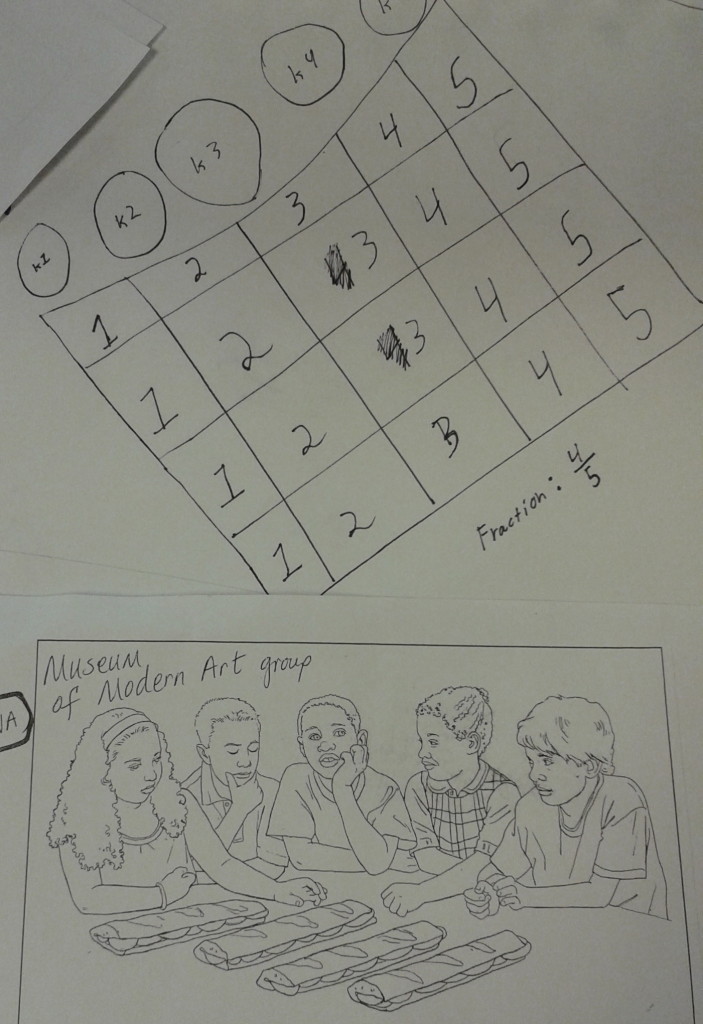When I think about what excites my students and me most about teaching and learning math, I think of real-world challenging scenarios like the Field Trip problem, which requires students to work collaboratively to solve a problem, evaluate their strategy, and produce a poster that stands alone (shows clearly labeled strategy and answer) that would ultimately be shard in a Math Congress (intentional group discussion) at the culmination of the lesson.
The scenario: A 4th grade class traveled on a field trip in four separate cars. The school provided a lunch of submarine sandwiches for each group. When they stopped for lunch, the subs were cut and shared as followed:
- The first had 4 students and shared 3 subs equally.
- The second group had 5 students and shared 4 subs equally.
- The third group had 8 students and shared 7 subs equally.
- The last group had 5 students and shared 3 subs equally.
When they returned from the field trip, the students began to argue that the distribution had not been fair, that some students got more to eat than the others. Your job today is to determine whether or not this distribution was fair. Did each student get the same amount of sandwich, no matter what group they were in?
I intentionally chose this problem for several reasons. First, it aligns perfectly with Common Core Standards including, but not limited to, 4.NF.A2 (comparing fractions with unlike denominators), 4.NF.B.3B (decomposing a fraction using visual fraction model), and the Standard for Mathematical Process of making sense of a word and persevering in solving. Next, I knew that I needed to step beyond the adopted Bridges program to provide an opportunity for a group work task-one that truly requires numerous strengths, as opposed to one or two. Finally, it’s fun. Doing a well-written problem with a group is a unique experience that includes encouraging, disagreeing, and thinking about strategies. When I am not instructing in the front of the room as the “all-knowing sage” and when there is not one “right” way to find the solution, the beauty of math emerges for everyone.
As an introduction to the problem, I shared with students 2 goals that I had for the day: #1- That I would not be helpful (I sometimes have a problem being way too helpful thereby inadvertently “doing the thinking for them” ) and #2- That I hoped students would really struggle with this problem.
Now that I had the class completely wide-eyed and alert, I shared a list of 10 requirements for being successful in this problem, including reading carefully and having the patience to re-read, thinking about fractions as division, dividing wholes into equal pieces, comparing fractions (>, <, =), and justifying (proving your thinking) with clearly labeled work. Not everyone has strength in each area, thus the requirement and beauty of valuing unique individual strengths though collaboration in a small group.
As groups began to work, my class took absolute ownership of problem solving strategies. Looking across the room, I noticed a group struggling. When I stepped in to help, one student quickly said, “Mrs. Nied—You said you wouldn’t help us. Give us a chance to figure it out on our own!” Could it get any better than that? Additionally, I observed groups with heads together, using language like, “I like how you said that,” “Could you help me understand your strategy,” “Don’t forget that we need everything labeled,” and “Yes! I figured it out!”
The most exciting outcome was that one of my students who typically has low status and would unlikely be asked for his ideas was literally the only one in the class who knew exactly what to do right away. His strategy:
 It was incredibly empowering to my student to be able to say to other groups who were absolutely stuck to go ask him to describe his strategy, and he was elated to share!
It was incredibly empowering to my student to be able to say to other groups who were absolutely stuck to go ask him to describe his strategy, and he was elated to share!
Through this problem, I observed two common misconceptions that occur when working with fractions. Using play-doh to build the sandwiches, many students began with first dividing each sandwich in half and giving each student in the group a half. Then, students took the remaining halves, broke them in half, until each student had the same about of play-doh pieces. Beyond the ½ of the sandwich, students lost track of what a ½ of a ½ is, and what a ½ of that is, and what a ½ of that, is etc. With the question requiring students to know how much each student was given, students did not know what the model that they correctly built represented. Another misconception occurred when students had to order fractions. Many students indicated on their posters that 7/8 is less than 5/6. When asked their reasoning, they said that the whole is broken into smaller pieces, so the fraction must be smaller, without taking into account the information provided by the numerator. Both of these misconceptions were discussed at the heart of our Math Congress.
In teaching and learning, there is nothing more powerful than when students take complete ownership of their work. As I think about how we started the year sharing how we feel about math, I am amazed at how far we have come! When I asked students today how they feel about math, they responded, “excited,” “like people listened to me,” and “happy,” whereas at the beginning of the year they said, “confused,” “sad,” “frustrated.” What a dramatic difference!!! It makes a significant impact when I say, “Remember the Field Trip problem” to students who are struggling in other areas as a reminder of what can be accomplished through perseverance.

